
A fortification is a military construction designed for the defense of territories in warfare, and is used to establish rule in a region during peacetime. The term is derived from Latin fortis ("strong") and facere.

The Kingdom of Prussia constituted the German state of Prussia between 1701 and 1918. It was the driving force behind the unification of Germany in 1866 and was the leading state of the German Empire until its dissolution in 1918. Although it took its name from the region called Prussia, it was based in the Margraviate of Brandenburg. Its capital was Berlin.
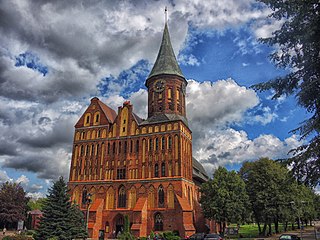
Prussia is a historical region in Central Europe on the south-eastern coast of the Baltic Sea, that ranges from the Vistula delta in the west to the end of the Curonian Spit in the east and extends inland as far as Masuria, divided between Poland, Russia and Lithuania.

Prussia was a German state located on most of the North European Plain, also occupying southern and eastern regions. It formed the German Empire when it united the German states in 1871. It was de facto dissolved by an emergency decree transferring powers of the Prussian government to German Chancellor Franz von Papen in 1932 and de jure by an Allied decree in 1947. For centuries, the House of Hohenzollern ruled Prussia, expanding its size with the Prussian Army. Prussia, with its capital at Königsberg and then, when it became the Kingdom of Prussia in 1701, Berlin, decisively shaped the history of Germany.
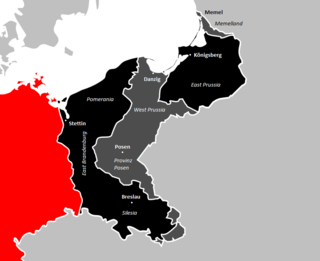
The former eastern territories of Germany refer in present-day Germany to those territories east of the current eastern border of Germany, i.e., the Oder–Neisse line, which historically had been considered German and which were annexed by Poland and the Soviet Union after World War II in Europe. In most of these territories, Germans used to be the dominant or sole ethnicity. In contrast to the lands awarded to the restored Polish state by the Treaty of Versailles after World War I, the German territories lost with the Potsdam Agreement after World War II in Europe on 2 August 1945 were either almost exclusively inhabited by Germans before 1945, mixed German-Polish with a German majority, or mixed German-Czech with a German majority (Glatz). Virtually the entire German population of the territories that did not flee voluntarily in the face of the Red Army advance of 1945, was violently expelled to Germany, with their possessions being looted and stolen.
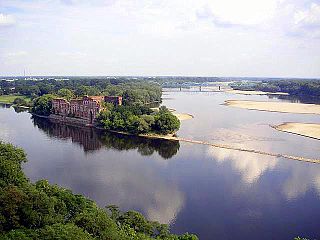
Modlin Fortress is one of the largest 19th-century fortresses in Poland. It is located in the town of Nowy Dwór Mazowiecki in district Modlin on the Narew river, approximately 50 kilometers north of Warsaw. It was originally constructed by the French from 1806 to 1812.
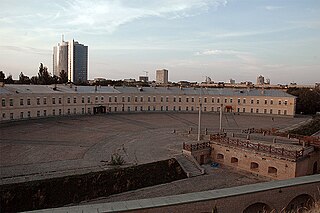
The Kyiv Fortress or Kiev Fortress is a historical and architectural monument complex of Russian fortifications in Kyiv, Ukraine built from the 17th through 19th centuries. Construction began after the 1654 Council in Pereiaslav, on the site of the already existing fortified monastery of Kyiv Pechersk Lavra. Located on the hills of the high right bank of the Dnieper, bounded on the north by the Klovsky ravine, on the south and west – by the slopes of the Lybid River valley.

The military history of the Russian Empire encompasses the history of armed conflict in which the Russian Empire participated. This history stretches from its creation in 1721 by Peter the Great, until the Russian Revolution (1917), which led to the establishment of the Soviet Union. Much of the related events involve the Imperial Russian Army, Imperial Russian Navy, and from the early twentieth century, the Imperial Russian Air Service.

Brest Fortress, formerly known as Brest-Litoŭsk Fortress, is a 19th-century fortress in Brest, Belarus. In 1965, the title Hero Fortress was given to the fortress to commemorate the defence of the frontier stronghold during the first week of Operation Barbarossa, when Axis forces invaded the Soviet Union on 22 June 1941. The title "Hero Fortress" corresponds to the title "Hero City" that the Presidium of the Supreme Soviet of the Soviet Union awarded to twelve Soviet cities.

Vladimir Aleksandrovich Sukhomlinov was a Russian general in the Imperial Russian Army who served as the Chief of the General Staff from 1908 to 1909 and the Minister of War from 1909 to 1915.

The Fortress of Luxembourg is the former fortifications of Luxembourg City, the capital of the Grand Duchy of Luxembourg, which were mostly dismantled beginning in 1867. The fortress was of great strategic importance for the control of the Left Bank of the Rhine, the Low Countries, and the border area between France and Germany.

Poznań Fortress, known in German as Festung Posen was a set of fortifications in the city of Poznań in western Poland, built under Prussian rule in the 19th and early 20th centuries. It represents the third largest system of its kind in Europe.
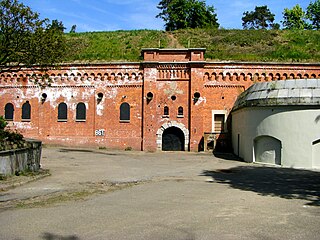
Toruń Fortress is a historic fortress located in Toruń, Poland, one of the largest fortresses in Central and Eastern Europe.

The Seven Years' War (1756–1763) was a global conflict involving most of the European great powers, fought primarily in Europe and the Americas. One of the opposing alliances was led by Great Britain and Prussia. The other alliance was led by France, backed by Spain, Saxony, Sweden, and Russia. Related conflicts include the 1754 to 1763 French and Indian War, and 1762 to 1763 Anglo-Spanish War.

The early modern era of Polish history follows the Late Middle Ages. Historians use the term early modern to refer to the period beginning in approximately 1500 AD and lasting until around the Napoleonic Wars in 1800 AD.
Under the terms of the 1815 Peace of Paris, France was obliged to pay for the construction of a line of fortresses to protect the German Confederation against any future aggression by France. All fortresses were located outside Austria and Prussia — the two biggest, bickering powers of the Confederation.

The Fort de Queuleu is a fortification to the southeast of Metz, near Queuleu, France. Construction began while part of Lorraine was under French rule in 1868. After the interruption of the Franco-Prussian War of 1870-71, the fort was improved between 1872 and 1875 by the German Empire, which had conquered the area in the war. Renamed Fort Goeben, it formed part of the first ring of the fortifications of Metz. Functionally obsolete by the First World War, it saw no military action, but was used by the Germans as a detention center for members of the French Resistance during World War II.

Fort Srebrna Góra or Srebrnogórska Fortress is a former military fort, now a monument and a museum, located in the village of Srebrna Góra, Lower Silesian Voivodeship, Poland. It was constructed in 1765–1777 when the territory was part of the Kingdom of Prussia.
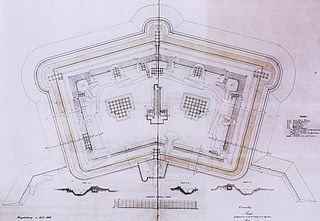
A polygonal fort is a type of fortification originating in France in the late 18th century and fully developed in Germany in the first half of the 19th century. Unlike earlier forts, polygonal forts had no bastions, which had proved to be vulnerable. As part of ring fortresses, polygonal forts were generally arranged in a ring around the place they were intended to protect, so that each fort could support its neighbours. The concept of the polygonal fort proved to be adaptable to improvements in the artillery which might be used against them, and they continued to be built and rebuilt well into the 20th century.
The siege of Longwy was a military conflict during the Franco-Prussian War, which took place from January 16 to the 25th, 1871, in the Longwy which was near the border of Belgium and Luxembourg. After the artillery fire from the Prussian army, the siege ended with the defenders of Longwy under the command of Colonel Massaroly surrendering to Prussia under the command of Colonel Von Cosel. With this victory, the Prussian army captured many prisoners and cannons of the enemy. This was one of the consecutive victories of the German army in a short period of time during the war. The town of Longwy was badly damaged during the siege.


















